Discover 35 hidden attractions, cool sights, and unusual things to do in Warsaw (Poland). Don't miss out on these must-see attractions: Royal Castle, Łazienki Park, and Warsaw Uprising Museum. Also, be sure to include Copernicus Science Centre in your itinerary.
Below, you can find the list of the most amazing places you should visit in Warsaw (Masovian).
Table of Contents
Royal Castle
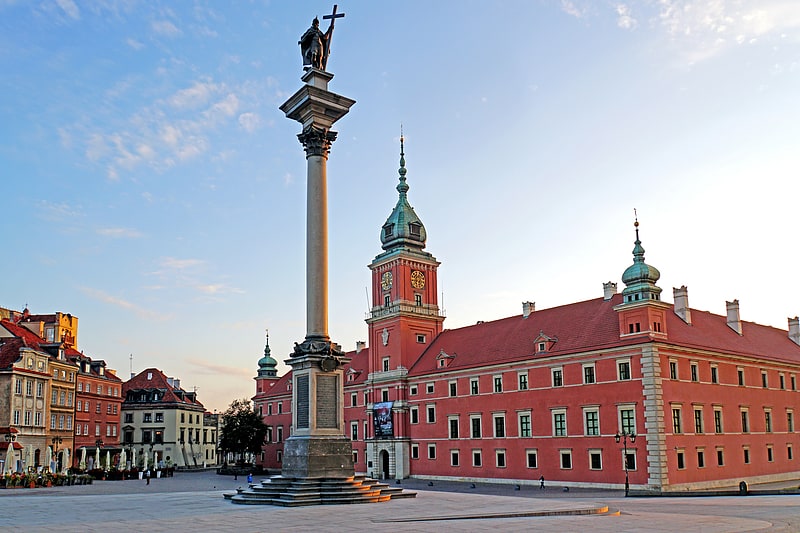
Also known as: Zamek Królewski w Warszawie
Former palace and museum with guided tours. The Royal Castle in Warsaw is a royal residence that formerly served throughout the centuries as the official home of Polish monarchs. It is situated in Castle Square, at the entrance to the Warsaw Old Town. The personal offices of the king and the administrative offices of the royal court were located in the Castle from the 16th century until the final partition of Poland in 1795.
Initially, the fortified complex served as the residence of the Masovian dukes. In the early 1600s, it was designated to replace Wawel Castle in Kraków as the seat of the King, Parliament (Chamber of Deputies and Senate), and the Polish–Lithuanian Commonwealth. The medieval Gothic structure was remodelled into Italian mannerism by architects Matteo Castelli and Giovanni Battista Trevano. The Baroque easternmost wing was designed by Gaetano Chiaveri and completed in 1747.
The Royal Castle witnessed many notable events in Poland's history; the Constitution of 3 May 1791, first of its type in Europe and the world's second-oldest codified national constitution, was drafted here by the Four-Year Parliament. The edifice was redesigned into a neoclassical style following the partitions of Poland. Under the Second Polish Republic (1918–1939), it was the seat of the Polish head of state and president.
The Second World War brought complete destruction to the building; in September 1939 it was targeted and ignited by Luftwaffe fighter aircraft, and then detonated by the Nazis after the failed Warsaw Uprising in 1944. In 1965, the surviving wall fragments, cellars, the adjacent Copper-Roof Palace and the Kubicki Arcades were registered as historical monuments. Reconstruction was carried out in the years 1971–1984, during which it regained its original 17th century appearance. In 1980, the Royal Castle and surrounding Old Town became a UNESCO World Heritage Site. Today, it serves as a museum annually visited by over 500,000 people, and one of Warsaw's most recognizable landmarks.[1]
Address: Plac Zamkowy 4, 00-277 Warsaw (Śródmieścia)
Łazienki Park
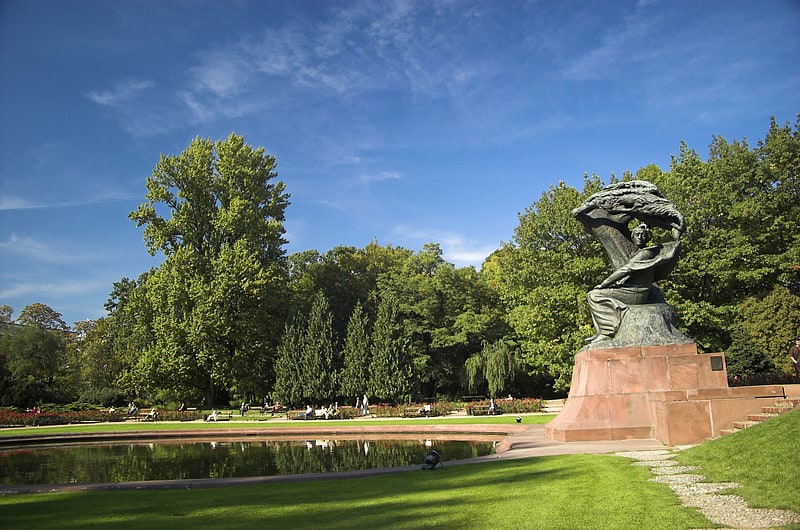
Also known as: Łazienki Królewskie w Warszawie
Royal collections in summer residence. Łazienki Park or Royal Baths Park is the largest park in Warsaw, Poland, occupying 76 hectares of the city center.
The park-and-palace complex lies in Warsaw's central district (Śródmieście) on Ujazdów Avenue, which is part of the Royal Route linking the Royal Castle with Wilanów Palace to the south. North of Łazienki Park, on the other side of Agrykola Street, stands Ujazdów Castle.
Originally designed in the 17th century as a baths park for nobleman Stanisław Herakliusz Lubomirski, in the 18th century Łazienki was transformed by Poland's last monarch, Stanislaus II Augustus, into a setting for palaces, villas, classicist follies, and monuments. In 1918 it was officially designated a public park.
Łazienki is visited by tourists from all over Poland and the world, and serves as a venue for music, the arts, and culture. The park is also home to peacocks and a large number of squirrels.[2]
Address: ul. Agrykoli 1, 00-460 Warszawa (Śródmieścia)
Warsaw Uprising Museum
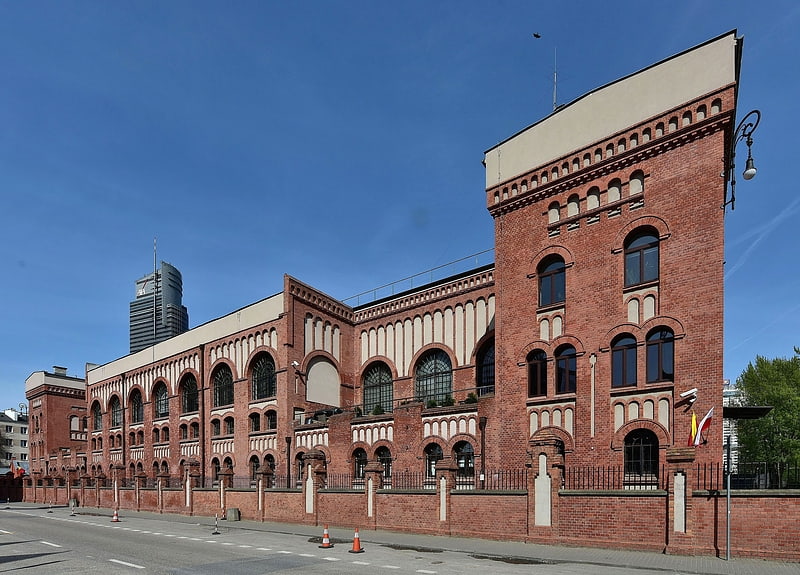
Also known as: Muzeum Powstania Warszawskiego
Museum devoted to 1944 Warsaw Uprising. The Warsaw Uprising Museum, in the Wola district of Warsaw, Poland, is dedicated to the Warsaw Uprising of 1944. The institution of the museum was established in 1983, but no construction work took place for many years. It opened on July 31, 2004, marking the 60th anniversary of the uprising.
The museum sponsors research into the history of the uprising, and the history and possessions of the Polish Underground State. It collects and maintains hundreds of artifacts — ranging from weapons used by the insurgents to love letters — to present a full picture of the people involved. The museum's stated goals include the creation of an archive of historical information on the uprising and the recording of the stories and memories of living participants. Its director is Jan Ołdakowski, with historian Dariusz Gawin from the Polish Academy of Sciences as his deputy.
The museum is a member organisation of the Platform of European Memory and Conscience.[3]
Address: Grzybowska 79, 00-844 Warszawa (Wola)
Copernicus Science Centre

Also known as: Centrum Nauki Kopernik w Warszawie
Museum in Warsaw, Poland. Copernicus Science Centre is a science museum standing on the bank of the Vistula River in Warsaw, Poland. It contains over 450 interactive exhibits that enable visitors to single-handedly carry out experiments and discover the laws of science for themselves. The Centre is the largest institution of its type in Poland and one of the most advanced in Europe. In 2018, since its opening, it had been visited by over 8 million people.
The first module of the Centre building was opened on 5 November 2010 with five galleries (On the move, Humans and the environment, Roots of civilization, Lightzone, Bzzz!); the exhibit for teenagers – RE: generation was opened 3 March 2011; a planetarium The Heavens of Copernicus opened on 19 June, the Discovery Park on 15 July, chemistry laboratory - 18 October; biology laboratory - 15 November, robotics workshop - 6 December, and physics laboratory - 20 December.
Since 2008, the Copernicus Science Centre together with Polish Radio has organized the Science Picnic - Europe's largest outdoor science-popularization event. In 2011 the Centre hosted the ECSITE conference (European Network of Science Centres and Museums) – one of the most important events in the field of science centres and museums in the world.[4]
Address: Wybrzeże Kościuszkowskie 20, 00-390 Warszawa (Śródmieścia)
Wilanów Palace
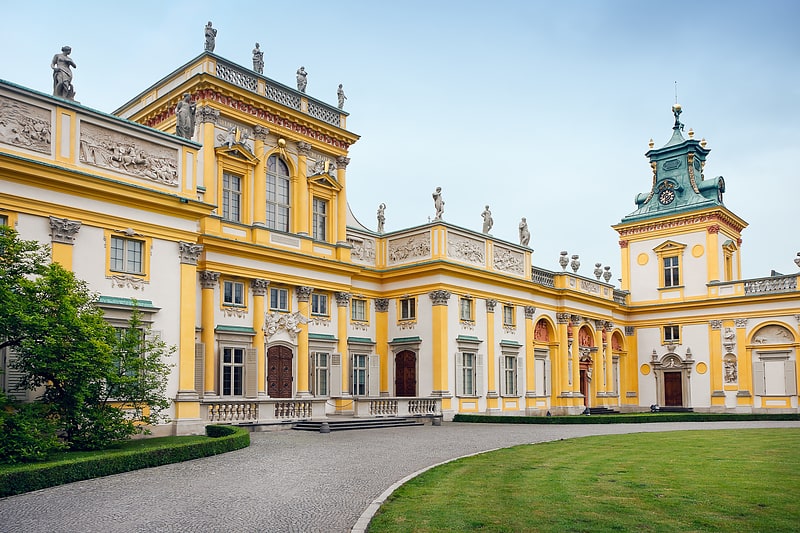
Also known as: Pałac w Wilanowie
Palace in Warsaw, Poland. Wilanów Palace is a former royal palace located in the Wilanów district of Warsaw, Poland. Wilanów Palace survived Poland's partitions and both World Wars, and so serves as a reminder of the culture of the Polish state as it was before the misfortunes of the 18th century.
It is one of Poland's most important monuments. The palace's museum, established in 1805, is a repository of the country's royal and artistic heritage and receives around 3 million visitors annually. The palace and park in Wilanów host cultural events and concerts, including Summer Royal Concerts in the Rose Garden and the International Summer Early Music Academy.
The palace, together with other elements of Warsaw Old Town, is one of Poland's official national Historic Monuments (Pomnik historii), as designated on 16 September 1994. Its listing is maintained by the National Heritage Board of Poland. Since 2006, the palace has been a member of the international association of European Royal Residences.[5]
Address: Stanisława Kostki Potockiego 10/16, 02-958 Warszawa (Wilanów)
Krasiński Palace
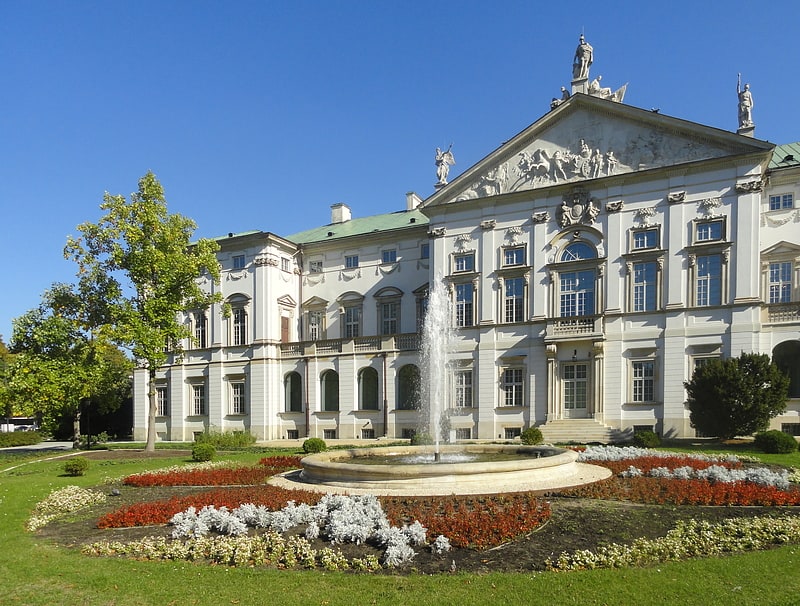
Also known as: Pałac Krasińskich w Warszawie
Baroque-style 17th-century palace. The Krasiński Palace, also known as the Palace of the Commonwealth, is a reconstructed Baroque palace in Warsaw, Poland, on Krasiński Square. Initially erected between 1677 and 1683 for the powerful Krasiński family, it was heavily damaged during World War II and rebuilt in the mid-20th century.[6]
Address: plac Krasińskich 3/5, 00-401 Warszawa (Śródmieścia)
National Museum
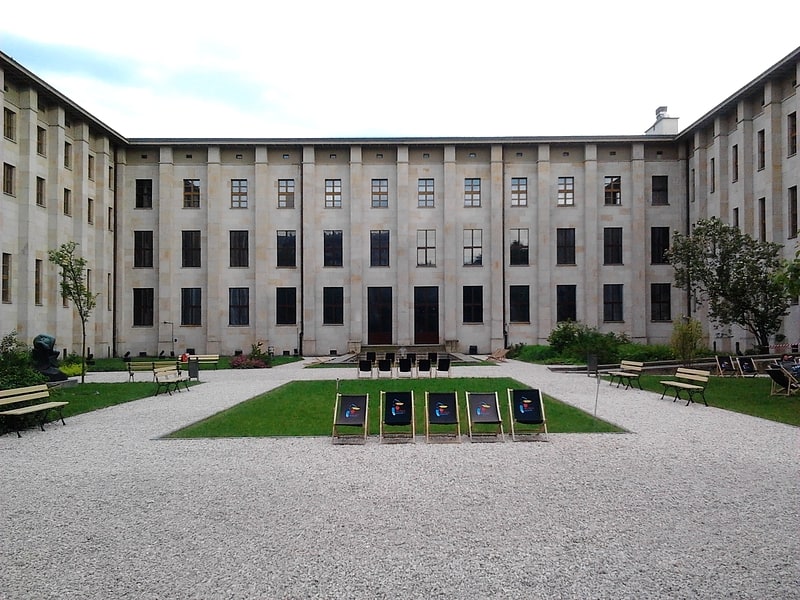
Also known as: Muzeum Narodowe w Warszawie
Art museum housed in modernist building. The National Museum in Warsaw, popularly abbreviated as MNW, is a national museum in Warsaw, one of the largest museums in Poland and the largest in the capital. It comprises a rich collection of ancient art, counting about 11,000 pieces, an extensive gallery of Polish painting since the 16th century and a collection of foreign painting including some paintings from Adolf Hitler's private collection, ceded to the Museum by the American authorities in post-war Germany. The museum is also home to numismatic collections, a gallery of applied arts and a department of oriental art, with the largest collection of Chinese art in Poland, comprising some 5,000 objects.
The Museum boasts the Faras Gallery with Europe's largest collection of Nubian Christian art and the Gallery of Medieval Art with artefacts from all regions historically associated with Poland, supplemented by selected works created in other regions of Europe.[7]
Address: al. Jerozolimskie 3, 00-495 Warszawa (Śródmieścia)
Brühl Palace
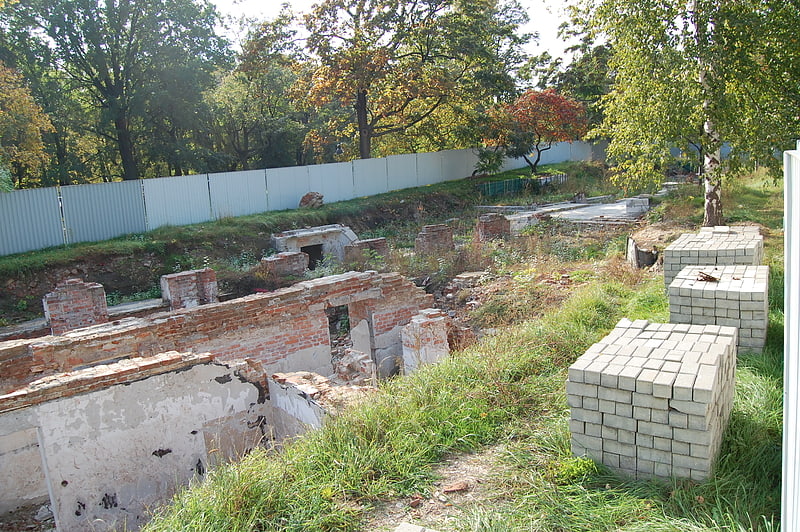
The Brühl Palace, formerly known as Sandomierski Palace, was a palatial residence standing at Piłsudski Square, in central Warsaw, Poland. It was one of the largest palaces and one of the finest examples of rococo architecture in pre-World War II Warsaw.[8]
Address: ul. Muzealna 8, Warsaw (Śródmieścia)
Warsaw Zoo

Also known as: Ogród Zoologiczny w Warszawie
Zoological garden in Warsaw, Poland. The Warsaw Zoological Garden, known simply as the Warsaw Zoo, is a scientific zoo located alongside the Vistula River in Warsaw, Poland. The zoo covers about 40 hectares in central Warsaw, and sees around 1,000,000 visitors annually, making it one of the busiest zoos in Europe. It is home to over 11,000 animals representing more than 500 species.
The zoo is an accredited member of the European Association of Zoos and Aquaria (EAZA) and the World Association of Zoos and Aquariums (WAZA).
The Warsaw Zoo served as a hiding spot for Jews and escapees from the Warsaw Ghetto during World War II. Zookeepers Jan and Antonina Żabiński, responsible for saving hundreds of Jews within the zoo premises, were eventually granted the title of Righteous Among the Nations for their contribution, effort and good will. These events were documented in the novel The Zookeeper's Wife by Diane Ackerman and in the 2017 war drama film starring Jessica Chastain.[9]
Address: Ratuszowa 1/3, 03-461 Warszawa (Praga Północ)
Saxon Palace

The Saxon Palace was one of the most distinctive buildings in prewar Warsaw, Poland. It was destroyed by German armed forces in World War II and not rebuilt as of 2020. There are however discussions regarding reconstruction of the building.[10]
Belweder

Classical palace and ex governmental seat. Belweder is a neoclassical palace in Warsaw, Poland. Erected in 1660 and remodelled in the early 1800s, it is one of several official residences used by Polish presidents as well as a state guest house for visiting heads of state. The complex is situated south of Warsaw's city center, in the vicinity of the historic Royal Baths Park.[11]
Address: Belwederska 54, 00-401 Warszawa (Śródmieścia)
Sigismund's Column
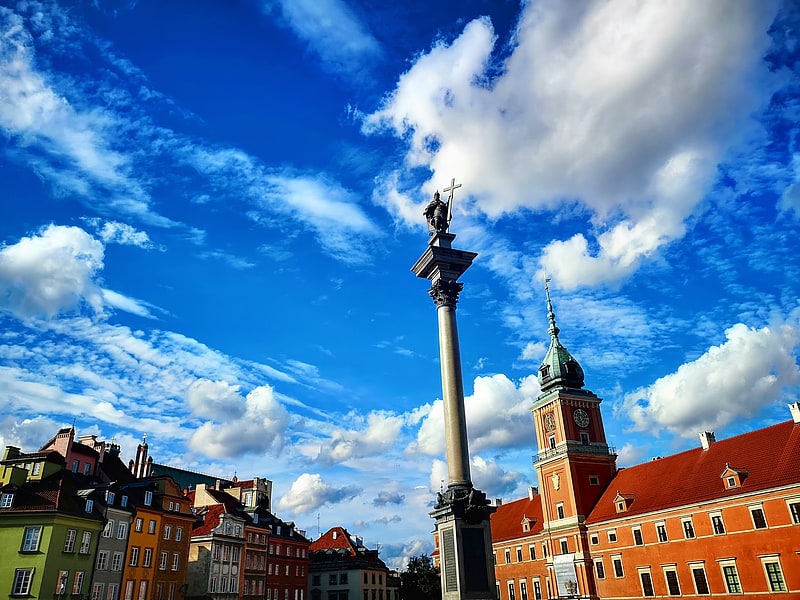
Also known as: Kolumna Zygmunta III Wazy w Warszawie
Landmark 17th-century royal monument. Sigismund's Column, originally erected in 1644, is located at Castle Square, Warsaw, Poland and is one of Warsaw's most famous landmarks as well as the first secular monument in the form of a column in modern history. The column and statue commemorate King Sigismund III Vasa, who in 1596 had moved Poland's capital from Kraków to Warsaw.
On the Corinthian column, 8.5 m high, a sculpture of the King, 2.75-metres high, in archaistic armour is placed. Sigismund's Column now stands at 22 metres and is adorned by four eagles. The king is dressed in armor and carries a cross in one hand and wields a sword in the other.[12]
Address: plac Zamkowy, 00-001 Warszawa (Śródmieścia)
Palace of Culture and Science
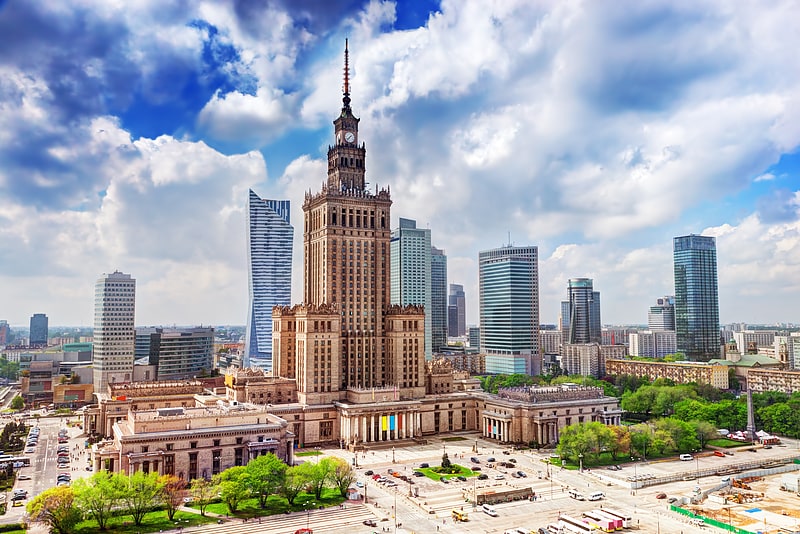
Also known as: Pałac Kultury i Nauki
1950s Soviet landmark for arts and culture. The Palace of Culture and Science is a notable high-rise building in central Warsaw, Poland. With a total height of 237 metres it is the second tallest building in both Warsaw and Poland after Varso, the 6th-tallest building in the European Union and one of the tallest on the European continent. Constructed in 1955, it houses various public and cultural institutions such as cinemas, theatres, libraries, sports clubs, university faculties, and authorities of the Polish Academy of Sciences. Since 2007, it has been enlisted in the Registry of Objects of Cultural Heritage.
Motivated by Polish historical architecture and American art deco high-rise buildings, the PKiN was designed by Soviet Russian architect Lev Rudnev in "Seven Sisters" style and is informally referred to as the Eighth Sister. The Palace was also the tallest clock tower in the world until the installation of a clock mechanism on the NTT Docomo Yoyogi Building in Tokyo, Japan.[13]
Address: Warsaw, Plac Defilad 1
Presidential Palace
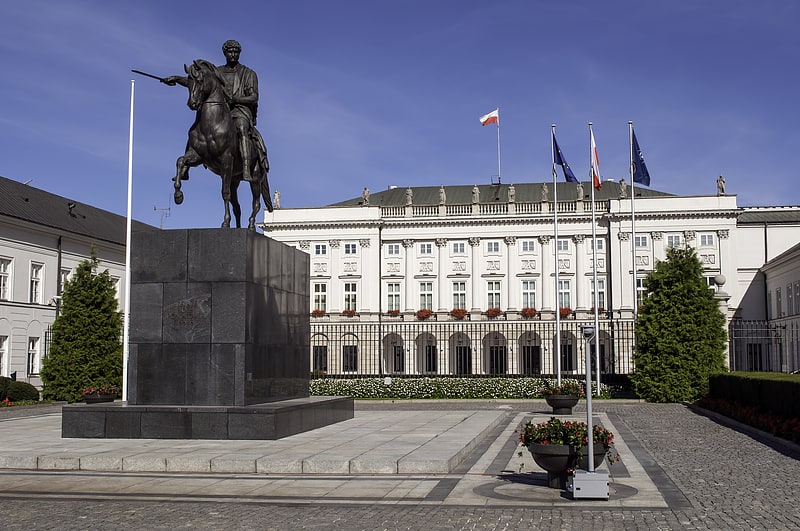
Also known as: Pałac Prezydencki w Warszawie
Palatial seat of Polish president. The Presidential Palace is the official residence of the Polish head of state and president alongside the Belweder Palace, located in Warsaw, Poland. Originally constructed in 1643 as an aristocratic mansion, it was rebuilt and remodelled several times over the course of its existence by notable architects. The current neoclassical palace was completed in 1818.
Throughout its history, the palace was a venue for important historical events in Polish, European, and world history. In 1791, the facility hosted authors and advocates of the Constitution of May 3, 1791, the first modern European constitution. In 1818, the palace began its ongoing career as a governmental structure when it became the seat of the Viceroy (namiestnik) of Congress Poland.
Following Poland's resurrection after World War I, in 1918, the building was taken over by the newly reconstituted Polish authorities and became the seat of the Council of Ministers. During World War II, it served as a Deutsches Haus for the country's German occupiers and survived the 1944 Warsaw Uprising intact. After the war, it resumed its function as seat of the Polish Council of Ministers. On 14 May 1955, the Warsaw Pact was signed inside the Presidential Palace between the Soviet Union and the Eastern Bloc countries. Since July 1994, the palace has been the official seat of the President of the Republic of Poland.[14]
Address: Warsaw, Krakowskie Przedmieście 46/48
Tomb of the Unknown Soldier
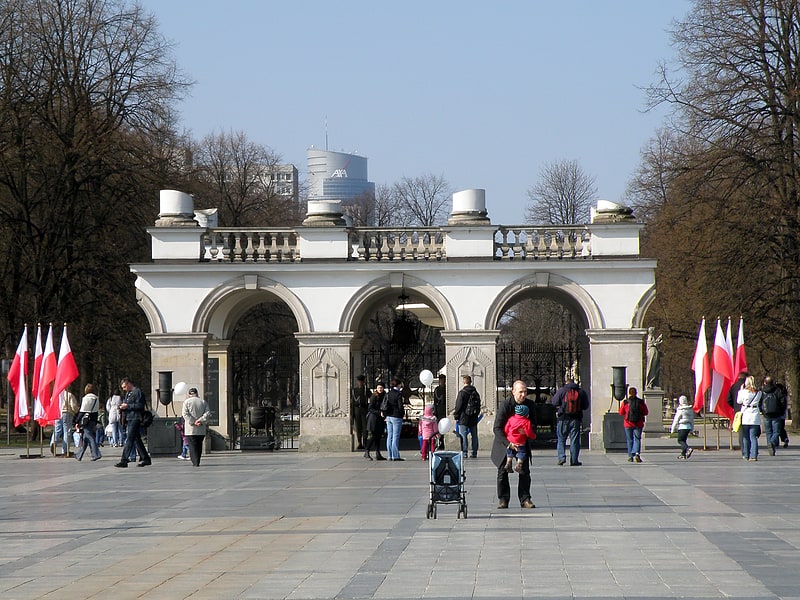
Also known as: Grób Nieznanego Żołnierza w Warszawie
Word War I memorial in 1700s palace. The Tomb of the Unknown Soldier is a monument in Warsaw, Poland, dedicated to the unknown soldiers who have given their lives for Poland. It is one of many such national tombs of unknowns that were erected after World War I, and the most important such monument in Poland.
The monument, located at Piłsudski Square, is the only surviving part of the Saxon Palace that occupied the spot until World War II. Since 2 November 1925 the tomb houses the unidentified body of a young soldier who fell during the Defence of Lwów. Since then, earth from numerous battlefields where Polish soldiers have fought has been added to the urns housed in the surviving pillars of the Saxon Palace.
The Tomb is constantly lit by an eternal flame and assisted by a guard post provided by the three companies of the 1st Guards Battalion, Representative Honor Guard Regiment of the Polish Armed Forces. It is there that most official military commemorations take place in Poland and where foreign representatives lay wreaths when visiting Poland.
The changing of the guard takes place every full hour, 365 days a year.[15]
Address: plac Marszałka Józefa Piłsudskiego 1-3, 00-078 Warszawa (Śródmieścia)
Uruski Palace
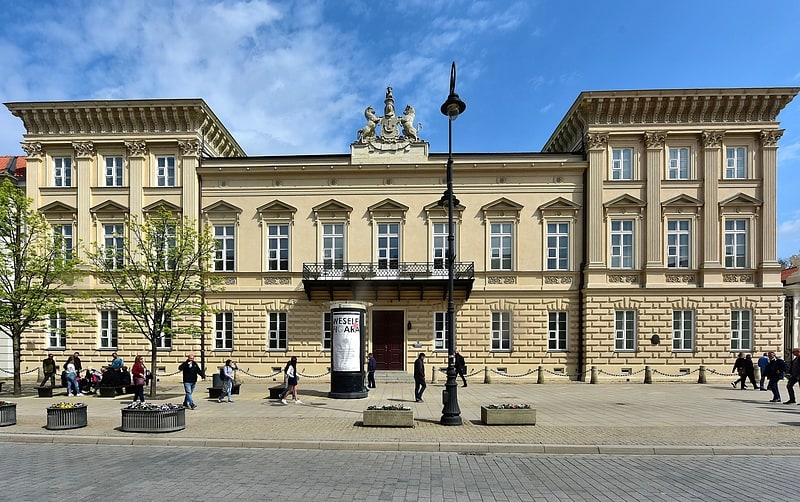
Also known as: Pałac Uruskich
Building in Warsaw, Poland. The Uruski Palace is a historical building located on Krakowskie Przedmieście in Warsaw, Poland.[16]
Address: Krakowskie Przedmieście 30, 00-401 Warszawa (Śródmieścia)
Old Town
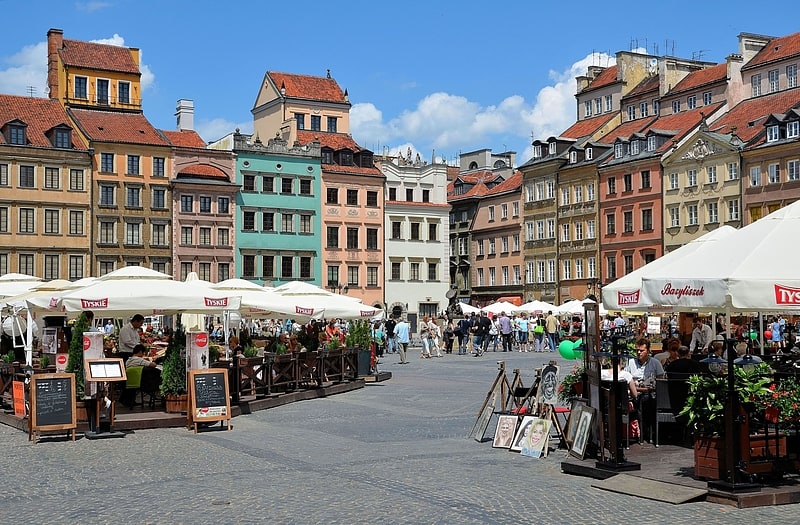
Also known as: Rynek Starego Miasta w Warszawie
Medieval square rebuilt after WWII. Warsaw's Old Town Market Place is the center and oldest part of the Old Town of Warsaw, capital of Poland. Immediately after the Warsaw Uprising, it was systematically blown up by the German Army. After World War II, the Old Town Market Place was restored to its prewar appearance.[17]
Polish Army Museum
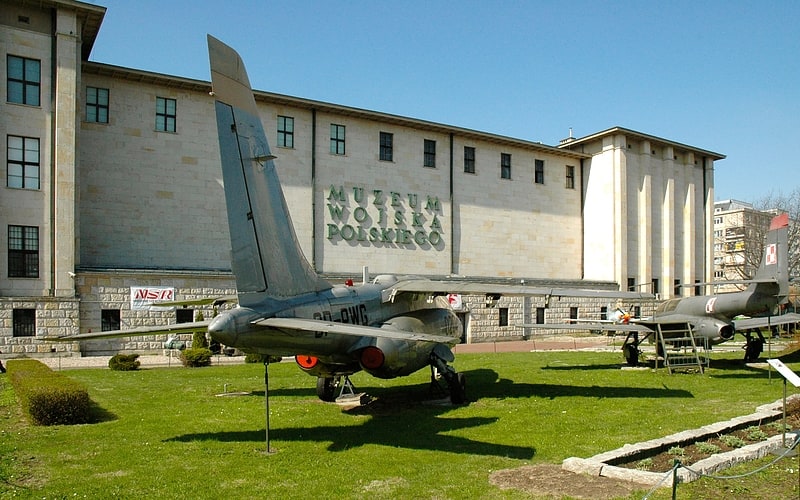
Also known as: Muzeum Wojska Polskiego w Warszawie
Military museum with tanks and planes. Museum of the Polish Army is a museum in Warsaw documenting the military history of Poland. Established in 1920 under the Second Polish Republic, it occupies a wing of the building of the Polish National Museum as well as several branches in Poland. It is Warsaw's second largest museum and the largest collection of military objects in Poland. The collection illustrates a thousand years of Polish military history, from the 10th century to the Second World War.[18]
Address: al. Jerozolimskie 3, 00-495 Warszawa (Śródmieścia)
Muzeum Azji i Pacyfiku

Museum in Warsaw, Poland. The Asia and Pacific Museum, in Warsaw, Poland, was founded in 1973 from a private collection of Oriental art amassed by Andrzej Wawrzyniak, sailor, diplomat, and connoisseur–collector of Oriental art. After returning to Poland, he donated his collection, numbering over 3,000 objects, to Poland. Thus the Museum of the Nusantara Archipelago was created in Warsaw in 1973.
In 1973 the Museum, continually enhanced with objects from oadditional regions of the world, became the Asia and Pacific Museum, with Wawrzyniak as its lifetime director and chief curator. The Museum's holdings include over 20,000 objects from Asia, Australia, and Oceania.[19]
Address: Solec 24, 00-403 Warszawa (Śródmieścia)
St. Anne's Church
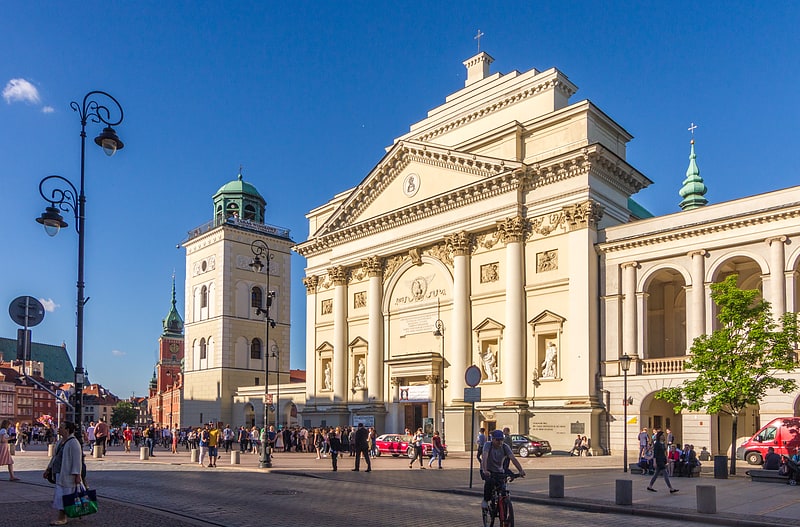
Also known as: Kościół św. Anny w Warszawie
Catholic church with Neoclassical facade. St. Anne's Church is a church in the historic center of Warsaw, Poland, adjacent to the Castle Square, at Krakowskie Przedmieście 68. It is one of Poland's most notable churches with a Neoclassical facade. The church ranks among Warsaw's oldest buildings. Over time, it has seen many reconstructions, resulting in its present-day appearance, unchanged since 1788. Currently it is the main church parish of the academic community in Warsaw.[20]
Address: Krakowskie Przedmieście 68, 00-322 Warszawa (Śródmieścia)
Palace on the Isle
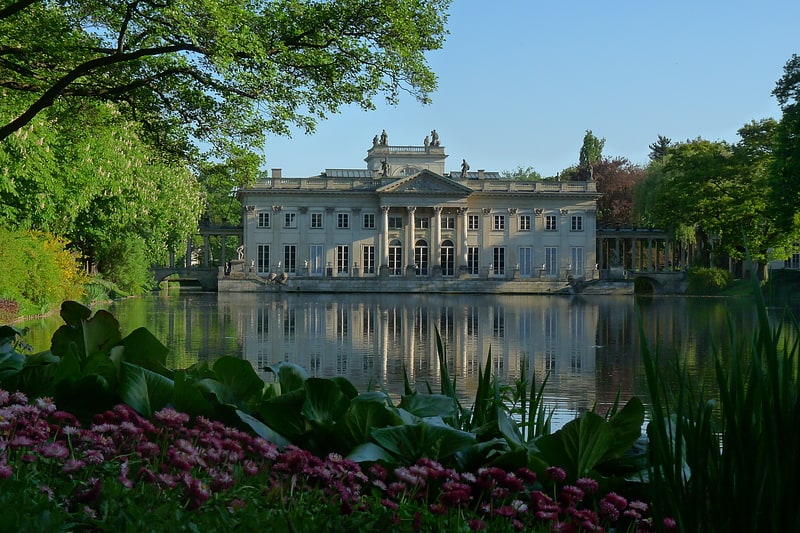
Also known as: Pałac Na Wyspie
18th-century palace with opulent decor. The Palace on the Isle, also known as Baths Palace, is a classicist palace in Warsaw's Royal Baths Park, the city's largest park, occupying over 76 hectares of the city center.
From 1674 the property and the nearby Ujazdów Castle belonged to Count Stanisław Herakliusz Lubomirski, who commissioned a Baroque bath house called "Łazienka", similarly to a number of other European historic sites, including England's city of Bath. The building, erected on a square plan, was richly decorated with stuccos, statues, and paintings; some of the original decorations and architectural details survive.
In 1766 King Stanislaus Augustus purchased the estate and converted the bathing pavilion into a classicist summer residence, with an English garden.
During the final stages of World War II, the retreating Germans devastated the interior of the Palace and drilled holes in the structure in preparation for destruction. However, the plan was never carried out.[21]
Address: ul. Agrykola 1, 00-460 Warsaw (Śródmieścia)
Copper-Roof Palace

Also known as: Pałac Pod Blachą w Warszawie
Former residence of Polish royal family. The Copper-Roof Palace is an 18th-century palace in Warsaw, Poland. It takes its name from the copper roof, a rarity in the first half of the 18th century. Since 1989 the Palace has been a branch of the Royal Castle Museum.
The palace is contiguous with Warsaw's Royal Castle, and down a slope from Castle Square and Warsaw's Old Town. Beneath the palace, a 17th-century lodge still exists.[22]
Address: 5 Zamkowy Square, 00-277 Warsaw (Śródmieścia)
Frederic Chopin Museum
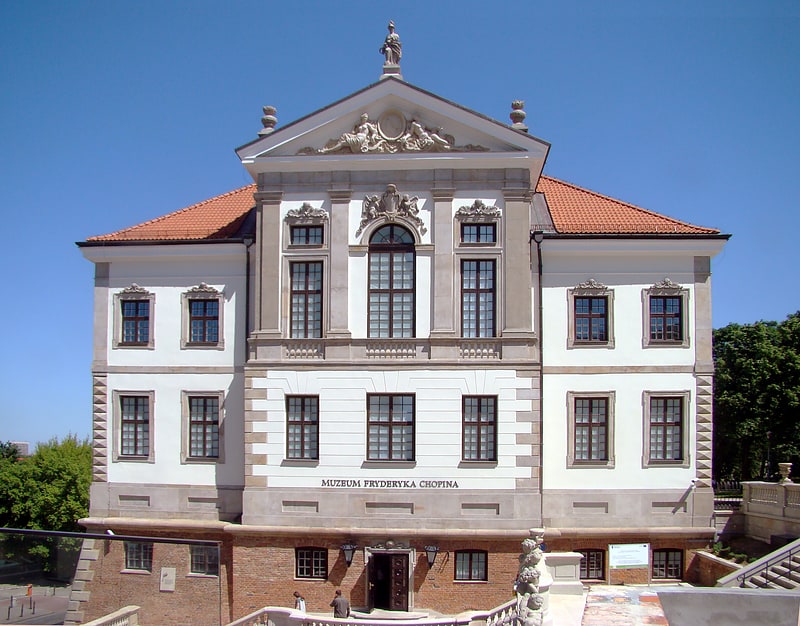
Also known as: Zamek Ostrogskich w Warszawie
Rebuilt mansion with a museum on Chopin. Ostrogski Palace, or Ostrogski Castle, is a fortified mansion in the city center of Warsaw, Poland, on Tamka Street. The castle was originally constructed for the powerful Ostrogski family in the 17th century. It currently houses the Fryderyk Chopin Society and the Fryderyk Chopin Museum.[23]
Address: ul. Okolnik 1, 00-368 Warsaw (Śródmieścia)
Saxon Garden
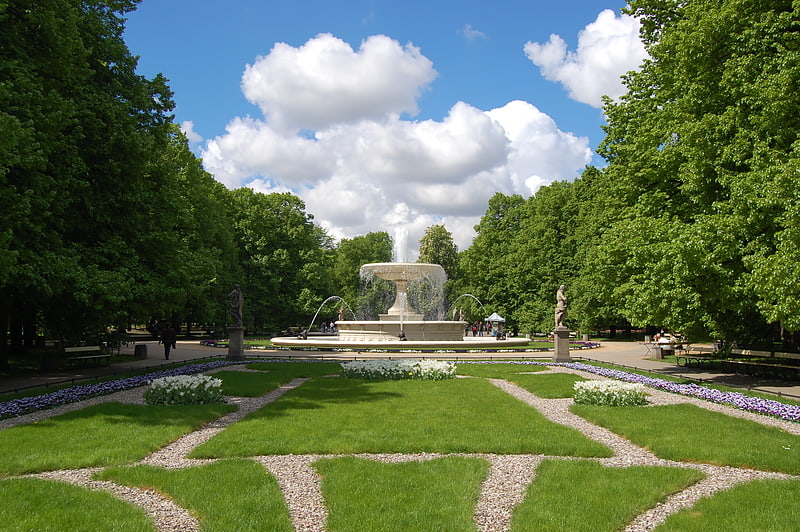
Also known as: Ogród Saski w Warszawie
Formal public park dating back to 1713. The Saxon Garden is a 15.5–hectare public garden in central Warsaw, Poland, facing Piłsudski Square. It is the oldest public park in the city. Founded in the late 17th century, it was opened to the public in 1727 as one of the first publicly accessible parks in the world.[24]
Warsaw Barbican
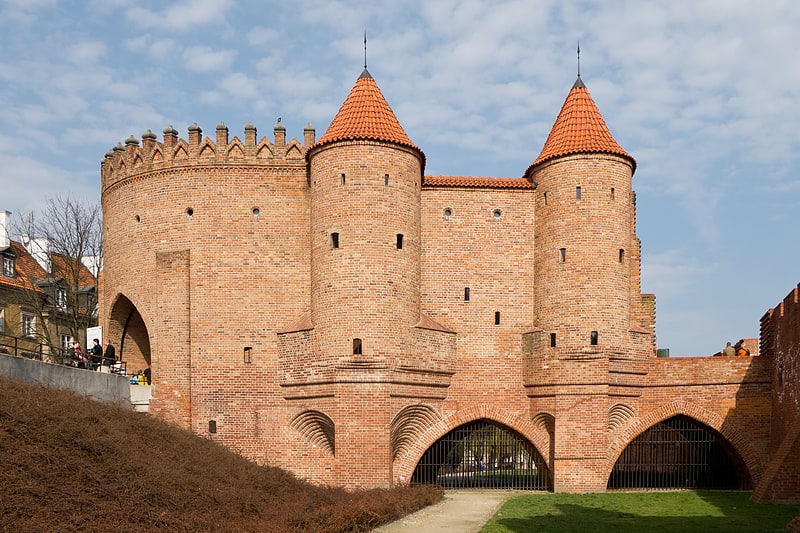
Also known as: Barbakan w Warszawie
16th-century defense wall of a castle. The Warsaw Barbican is a barbican in Warsaw, Poland, and one of few remaining relics of the complex network of historic fortifications that once encircled Warsaw. Located between the Old and New Towns, it is a major tourist attraction.[25]
Address: ul. Nowomiejska, 00-272 Warsaw (Śródmieścia)
Kazimierz Palace

Also known as: Pałac Kazimierzowski w Warszawie
Palace in Warsaw, Poland. The Kazimierz Palace is a rebuilt palace in Warsaw, Poland. It is adjacent to the Royal Route, at Krakowskie Przedmieście 26/28.
Originally built in 1637-41, it was first rebuilt in 1660 for King John II Casimir (Polish: Jan II Kazimierz Waza, from whom it takes its name) and again in 1765-68, by Domenico Merlini, for the Corps of Cadets established by King Stanisław II Augustus.
Since 1816, the Kazimierz Palace has served intermittently as the seat of Warsaw University (which was closed by the Russian Imperial authorities after each Uprising on the part of their Polish subjects, and in 1939-44 by the Germans).[26]
Świętokrzyski Bridge
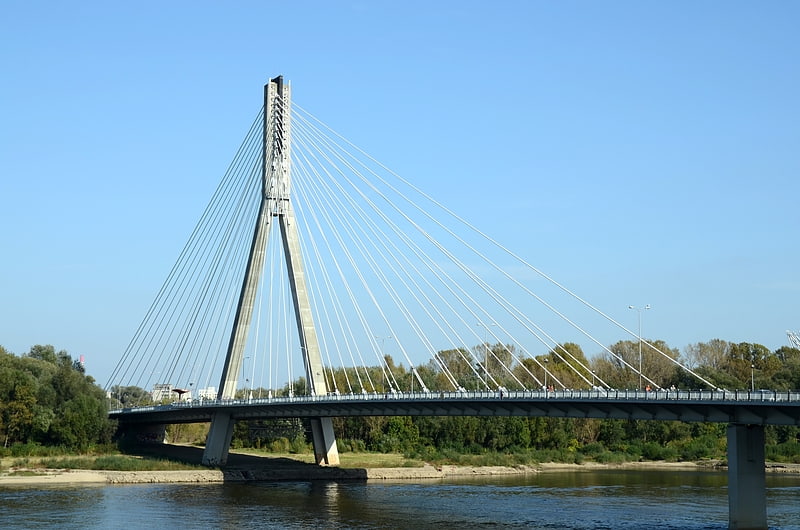
Also known as: Most Świętokrzyski
Bridge in Warsaw, Poland. The Świętokrzyski Bridge is a bridge over the Vistula river in Warsaw, Poland linking Powiśle neighbourhood with Praga Północ district.
It is a cable-stayed bridge, 479 m long, with two lanes for vehicles, a pavement and a cycle path each way. The single tower, 90 m high, located on the right (eastern) river bank, has 48 cables attached supporting the deck. Near the left (western) bank the bridge is supported by two piers. The bridge was opened on 6 October 2000 after two years' construction.
The bridge's name comes from Świętokrzyska Street, which forms part of the access route from the city centre.
According to the data from Stołecznego Zarządu Dróg Miejskich (Capital City Road Authority) in 2018, on average 23,418 vehicles passed the Świętokrzyski Bridge daily.[27]
Powązki Cemetery
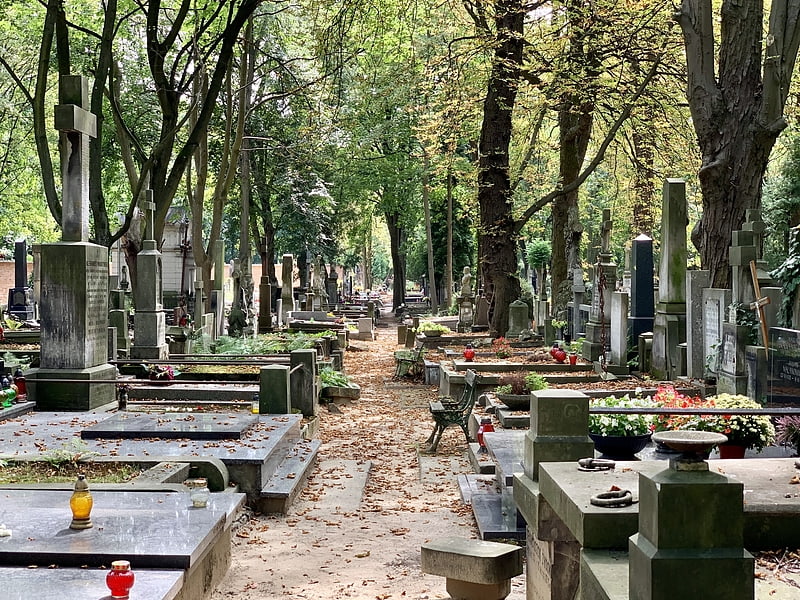
Also known as: Cmentarz Powązkowski w Warszawie
Cemetery in Warsaw, Poland. Powązki Cemetery, also known as Stare Powązki, is a historic necropolis located in Wola district, in the western part of Warsaw, Poland. It is the most famous cemetery in the city and one of the oldest, having been established in 1790. It is the burial place of many illustrious individuals from Polish history. Some are interred along the "Avenue of the Distinguished" - Aleja Zasłużonych, created in 1925. It is estimated that over 1 million people are buried at Powązki.
The cemetery is often confused with the newer Powązki Military Cemetery, which is located to the north-west of Powązki Cemetery.[28]
King John III Palace Museum
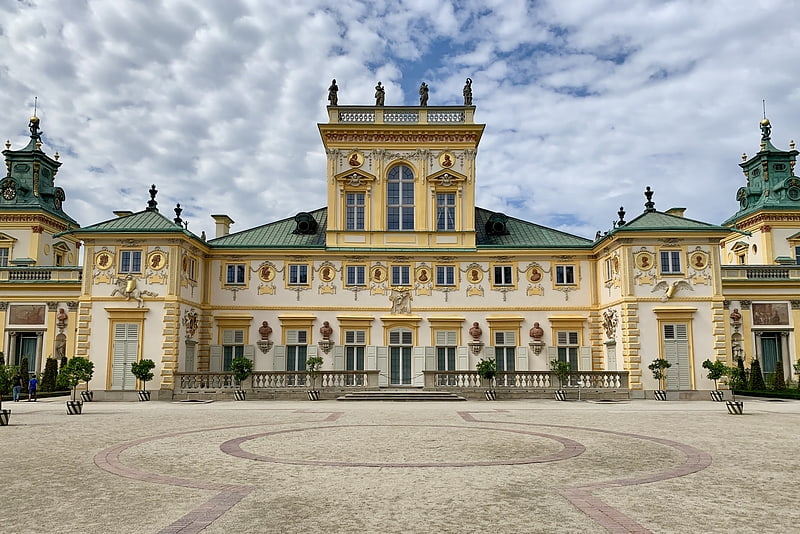
Also known as: Muzeum Pałacu Króla Jana III w Wilanowie
Museum in Warsaw. The Museum of King John III's Palace at Wilanów is a museum in Warsaw, Poland considered to be one of the oldest in the country and the repository of the country's royal and artistic heritage. The collection consists of valuables collected by subsequent owners of the Wilanów Palace, the Kings of Poland — John III Sobieski and Augustus II, as well as by representatives of noble families of Potocki, and Lubomirski and a collection of Sarmatian art.[29]
Address: Stanislawa Kostki Potockiego 10/16, 02-958 Warsaw (Wilanów)
Church of Our Lady of Loreto
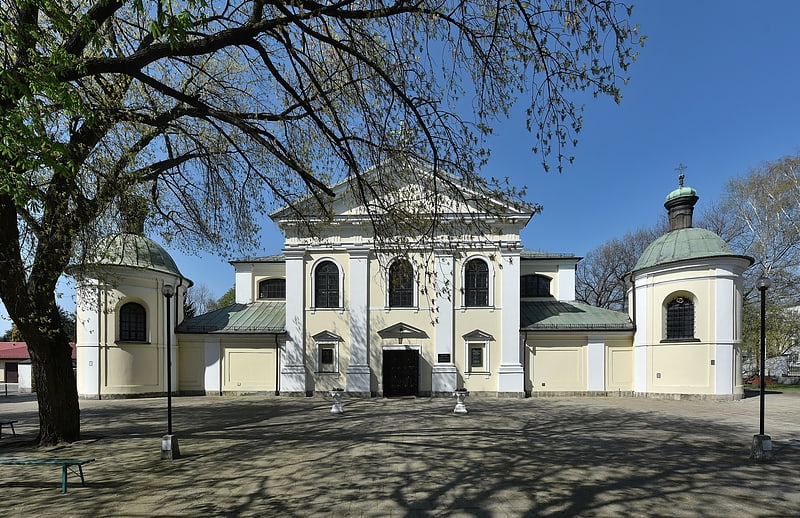
Also known as: Kościół Najświętszej Matki Bożej Loretańskiej w Warszawie
The Church of Our Lady of Loreto is an ornate church in Praga, a district of Warsaw, Poland, on the east bank of the Vistula River. The church stands on Ratuszowa Street and is Praga’s oldest monument. What may be seen today is a former chapel that on its south side was once attached to a baroque church and a Bernardine monastery.[30]
Address: Ratuszowa 5a, Warsaw (Praga Północ)
Fryderyk Chopin Museum
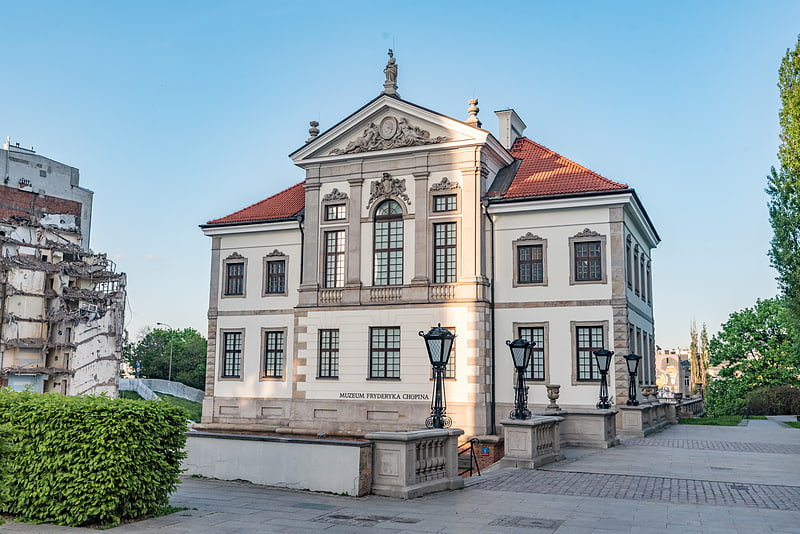
Also known as: Muzeum Fryderyka Chopina w Warszawie
Elegant mansion with Chopin collection. The Fryderyk Chopin Museum is a museum in Warsaw, Poland, established in 1954 and dedicated to Polish composer Frédéric Chopin. Since 2005, the Museum has been operated by the Fryderyk Chopin Institute.
A department of the Museum is the Birthplace of Frédéric Chopin at Żelazowa Wola. The Museum also operated the Chopin family parlor on Krakowskie Przedmieście, in Warsaw, until the parlor's closure in 2014.[31]
Address: Okolnik 1, 00-368 Warsaw (Śródmieścia)
Śląsko-Dąbrowski Bridge
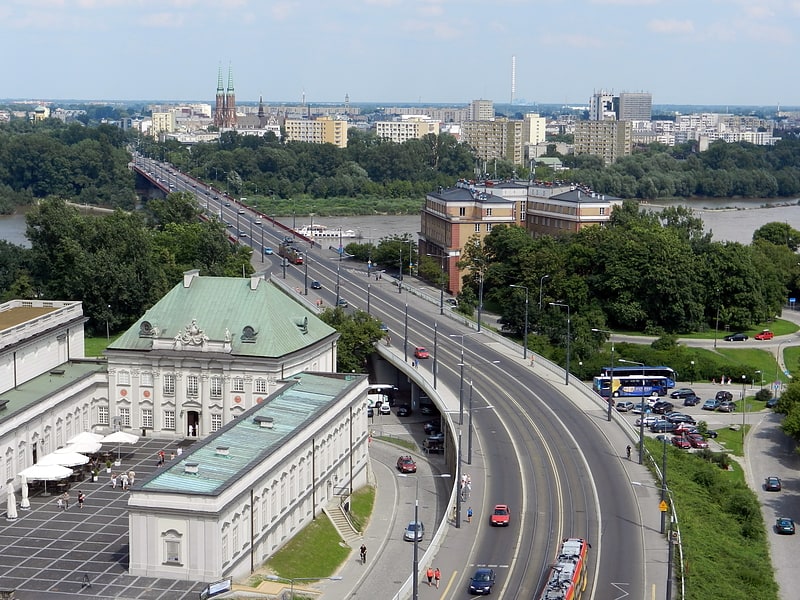
Also known as: Most Śląsko-Dąbrowski
Bridge in Warsaw, Poland. Śląsko-Dąbrowski Bridge is a bridge over the Vistula River in Warsaw. It was built from 1947 to 1949 on the pillars which remained from the Kierbedzia Bridge which had been destroyed in World War II. Due to the bridge's completely different structure, it is recognized as a new bridge, not a rebuilt one.
The name of the bridge commemorates the contribution of regions of Silesia and the Dąbrowa Basin in the reconstruction of the capital after the devastation of World War II.
The bridge is an integral portion of the Warsaw W-Z Route main thoroughfare that, from 22 July, 1949, joined Praga in the east (one of Warsaw's least destroyed districts during World War II) with the city center, going through Muranów and out to Wola in the west.
Unlike most of the Warsaw tram tracks, trams on this bridge originally shared the bridge space with cars. In 2007, due to increased tram traffic along Route WZ during the modernization of tram routes on another major thoroughfare, Aleje Jerozolimskie, the tramway was separated from the roadway. This separation has continued even after traffic returned to normal and since 2009 the tramway also serves as a bus lane, significantly shortening travel times for public transport in the area.
The bridge has been renovated regularly including from 1992 to 1993 and in 2009.
There are plaques on the bridge commemorating events that took place on the older Kierbedzia Bridge:
- for Zbigniew Gęsicki (aka Juno) and Kazimierz Sott (aka Sokół - Falcon), who were participants in the Home Army's assassination of Franz Kutschera in 1944. They had fled from the Germans and jumped from the bridge into the Vistula River where they were either drowned or shot
- to commemorate fighting on the bridge on 13 and 14 September, 1944 during the Warsaw Uprising
Jesuit Church
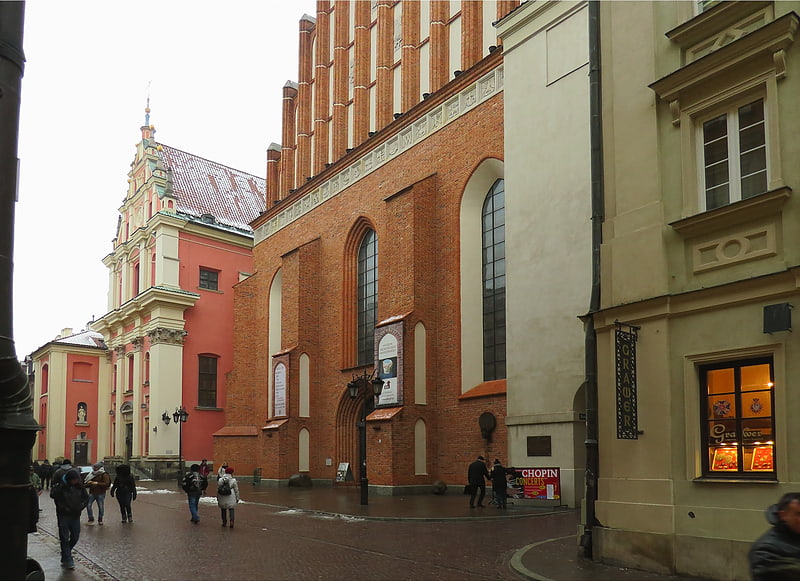
Also known as: Kościół Matki Bożej Łaskawej w Warszawie
Monument in Warsaw, Poland. The Jesuit Church, also known as Church of the Gracious Mother of God, is an ornate church within the Old Town precinct in Warsaw, Poland. The temple stands on Świętojańska Street, adjacent to St John's Cathedral, and is one of the most notable mannerist-style churches in Warsaw.[33]
Address: Ul. Świętojańska 10, Warsaw (Śródmieścia)
Cmentarz Wojskowy na Powązkach

Cemetery in Warsaw, Poland. Powązki Military Cemetery is an old military cemetery located in the Żoliborz district, western part of Warsaw, Poland. The cemetery is often confused with the older Powązki Cemetery, known colloquially as "Old Powązki". The Old Powązki cemetery is located to the south-east of the military cemetery.
The military cemetery holds the graves of many who have fought and died for their country since the early 19th century, including a large number involved in the 1920 Battle of Warsaw, the September 1939 Campaign, and the ill-fated 1944 Warsaw Uprising against Nazi Germany.[34]
Zachęta

Museum of global contemporary art. The Zachęta National Gallery of Art is a contemporary art museum in the center of Warsaw, Poland. The Gallery's chief purpose is to present and support Polish contemporary art and artists. With numerous temporary exhibitions of well-known foreign artists, the gallery has also established itself internationally.
The word "zachęta" means encouragement. The Zachęta Gallery takes its name from Towarzystwo Zachęty do Sztuk Pięknych (the Society for Encouragement of the Fine Arts), founded in Warsaw in 1860.[35]
Address: pl. Małachowskiego 3, 00-916 Warszawa (Śródmieścia)